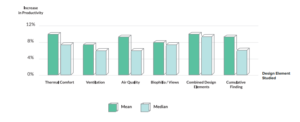September 24, 2020
Thermal Comfort + Performance
Thermal Comfort - Performance Research Brief
Summary
Performance effects are typically minimal when temperature falls within local comfort range. Most notable productivity decline is seen when temperature is outside noted comfort ranges (as prescribed by ASHRAE Standard 55).
Overview
I. Impacts
Investing in strategies that improve thermal comfort in buildings will support occupant productivity and health over the lifespan of a building. Buildings that deliver improved thermal comfort will enable occupants to be healthier and more productive which can benefit an organization both economically and in output efficiency (McCartney 2002, Zeiler 2009). Studies have found that temperature can significantly influence performance (McCartney 2002, Cui 2013, Seppanen 2006, Lee 2012, Fisk 2004). Figure 1 illustrates findings from a Stok Institute report that reviewed multiple publications. They found that thermal comfort has the single greatest effect on productivity in comparison with other design elements such as ventilation, air quality, and biophilia/views (Attema 2018).

Figure 2: Impact of indoor environmental quality on productivity from Attema et al. (Attema 2018)
II. The Optimal Temperature for Human Performance
One study of a US office building found that cognitive function of employees decreased when exposed to consistently cold temperatures. The same reduction appeared when exposed to consistently warm temperatures (Cui 2013, Lee 2012, Rupp 2015). Several studies have found that perceived thermal comfort in classrooms showed improvements of productivity and performance (Zeiler 2009, Zomorodian 2016). The optimal temperature range for cognitive function was found to be between 22-26 degrees Celsius (71.6-78.8 degrees Fahrenheit) (Seppanen 2006, Rupp 2015). Optimal temperatures for performance can vary due to the type of task (Zeiler 2009, Heerwagen 2000, Tarantini 2017, Chang 2019). Study subjects engaged in creativity-oriented tasks perform better in slightly warmer environment than average while those performing critical thinking tasks did better in spaces on the cooler end of the comfort spectrum (Heerwagen 2000, Chang 2019).
III. Impact of Gender on Thermal Comfort
Perceptions of thermal comfort can also vary by gender. A study looking at the influence of gender on thermal comfort asked participants to perform simulated office tasks and analyzed temperatures on the body while recording their perception of comfort. The study found that women were 4.5 times more likely to complain about cold extremities and their skin temperatures were significantly cooler than the male participants. The male participants in this study showed higher overall performance in the cooler environments than the female subjects (Schellen 2012). Another study conducted in Germany measured how the effects of temperature on cognitive performance varied based on gender (Chang 2019). This experiment had over 500 individuals perform math, verbal, and cognitive reflection tasks while only altering the temperature. The findings show that women had higher scores in warmer temperatures and that males performed better in lower temperatures. However, the impact was significantly higher for the women with a 1.76% increase in performance at the higher temperature. The change in men’s performance was not statistically significant (Chang 2019).
Seppanen and Fisk et al performed a statistical analysis of 24 studies and derived an equation that relates room temperature and employee performance (Seppanen 2006). Researchers at the Indoor Environment Group of the Lawrence Berkeley National Laboratory used these findings to illustrate the impact of temperature changes on performance of employees (Table 1).
IV. References
Review Articles
- Attema, J.E., Fowell, S.J., Macko, M.J., & Neilson, W.C. (2018). The Financial Case For High Performance Buildings. San Francisco: Stok, LLC.
- Fisk, William J., Olli Seppanen, and David Faulkner. “Control of temperature for health and productivity in offices.” (2004).
- McCartney, K.J., and M.A.Humphreys. “Thermal comfort and productivity.” Proceedings of Indoor Air 2002 (2002): 822-827.Applied Ergonomics 37, no. 4 (2006): 461-66.
- Rupp, Ricardo Forgiarini, Natalia Giraldo Vásquez, and Roberto Lamberts. “A review of human thermal comfort in the built environment.” Energy and Buildings 105 (2015): 178-205.
- Seppanen, O, Fisk, W.J., Lei, Q.H. “Room temperature and productivity in office work” Lawrence Berkeley National Laboratory 2006
- Tarantini, Mariantonietta, Giovanni Pernigotto, and Andrea Gasparella. “A Co-Citation Analysis on Thermal Comfort and Productivity Aspects in Production and Office Buildings.” Buildings 7, no. 4 (2017): 36.
- Zeiler, Wim, and Gert Boxem. “Effects of thermal activated building systems in schools on thermal comfort in winter.” Building and Environment 44, no. 11 (2009): 2308-2317.
- Zomorodian, Zahra Sadat, Mohammad Tahsildoost, and Mohammadreza Hafezi. “Thermal comfort in educational buildings: A review article.” Renewable and sustainable energy reviews 59 (2016): 895-906.
Primary Research
- Chang, Tom Y., and Agne Kajackaite. “Battle for the thermostat: Gender and the effect of temperature on cognitive performance.” PloS one 14, no. 5 (2019): e0216362.
- Cui, Weilin, Guoguang Cao, Jung Ho Park, Qin Ouyang, and Yingxin Zhu. “Influence of indoor air temperature on human thermal comfort, motivation and performance.” Building and environment 68 (2013): 114-122
- Heerwagen, Judith. “Green buildings, organizational success and occupant productivity.” Building Research & Information 28, no. 5-6 (2000): 353-367.
- Lee, M. C., K. W. Mui, L. T. Wong, W. Y. Chan, E. W. M. Lee, and C. T. Cheung. “Student learning performance and indoor environmental quality (IEQ) in air-conditioned university teaching rooms.” Building and Environment 49 (2012): 238-244.
- Schellen, Lisje, Marcel GLC Loomans, Martin H. de Wit, Bjarne Wilkens Olesen, and W. D. van Marken Lichtenbelt. “The influence of local effects on thermal sensation under non-uniform environmental conditions—Gender differences in thermophysiology, thermal comfort and productivity during convective and radiant cooling.” Physiology & behavior 107, no. 2 (2012): 252-261.
Last Updated: November 1, 2020
